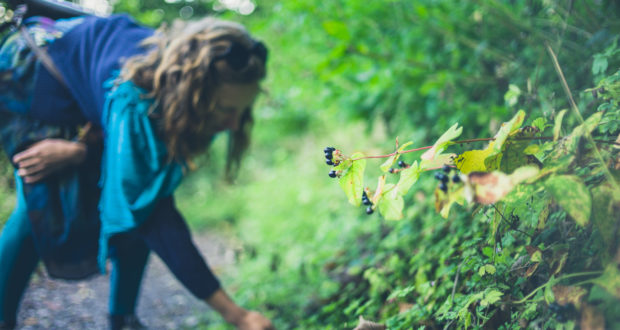|
Listen To The Article |

Always ask landowners before wildcrafting and foraging.
Wildcrafting is the term that people refer to for collecting wild plants. Wild plants often have strong healing properties and exceptional flavor. I have never tasted a store bought strawberry that compared in flavor to the tiny alpine ones that grow freely in wild places. All in all, wildcrafting can be lots of fun. It is an excellent way to teach children about nature.
There are several guidelines that you will need to follow to protect you and the plants when in the wild.
Legally, be sure that you are allowed to gather if you are on public or private property. Moreover, always ask permission from landowners. You may be required to obtain a permit on public lands.
Educate yourself about plants prior to gathering. Carry a minimum of two field guides with you to aid with plant identification unless you are absolutely sure that you can correctly identify the plants that you are gathering. In particular, mushrooms and plants in the parsley and carrot family are often misidentified. Consuming the wrong plant may cause illness or death in some cases.
Plant An Entire One Acre Survival Garden
Wildcrafting Rules Of Thumb
Learn what plants are endangered or at risk in your locale. State and federal agencies provide resource lists. Specifically, United Plant Savers is an organization that provides current information about medicinal herbs and their status in the wild. Sometimes plants may be abundant locally, yet be at risk or endangered as a whole. Never gather endangered or at-risk plants. Learn what common plants you can use as substitutes. If you purchase endangered or at-risk herbs, only purchase them from cultivated organic sources. If you desire to use at-risk herbs, plant your own. When planting, place them in habitats similar to their natural environments.
Gather a maximum of 10 percent of common herbs. Many herbalists replant as they gather. This is an excellent sustainable practice.
Wild stands of herbs and edibles are nature’s perennial gardens. Be respectful. Treat the wild garden with the same respect that you would treat a cultivated garden.
Wildcrafting Strategy
Select your foraging locale carefully. Do not harvest next to roads or in places that may have been sprayed with pesticides. Furthermore, only pick if there are large stands of plants present. Examine the stand of plants. Does it appear healthy? Is there evidence that other people have been harvesting there? Is it a fragile environment or one that will be negatively impacted by human presence? Know the area well. Ideally, you should observe the locale over several years to ensure the health of the plant stand. If it is growing and vigorous, then gather. If it is shrinking or unhealthy, do not collect at that site.
Remember that animals rely on native plants for survival. Consider the needs of local bears, birds, and other creatures, especially when harvesting fall nuts, fruits, and berries.
Additionally, if you are harvesting near hiking trails, only pick foods and herbs away from the trails. Allow others to see the beauty of the wild environment.
Do not pick all of the best specimens. Leave the outstanding flowers, seeds, and berries to strengthen the stand for the future.
Gather at the correct time of the day and year. Ideally, you should gather above ground plant parts in the late morning or early afternoon. Medicinal properties are stronger at those times. Also, dew has had time to dry so plants are less likely to decompose or mold.
Amazing All Natural Fertilizer Doubles Garden Production
Wildcrafting Plans And Purpose
Your best opportunity to gather roots and bark will be either in fall or spring. You should gather leaves and flowers when they are young. In addition, be sure to gather berries and nuts when ripe. Whenever possible, use plant parts from above the ground. If gathering roots, only remove a piece of a root. Replace the plant and water it. On the whole, only gather what you will use.
It makes no sense to gather plants if you are not going to prepare them promptly for storage. Will you be air drying on an extended camping trip? Are you returning home immediately to preserve the nutrients at their peak of freshness? Do you need to bring alcohol, vinegar, or glycerin for tincture making? Will you make an herbal oil on site? If you are planning to consume your bounty in the wild, is there fresh clean water available to wash the herbs, vegetables, and fruits? If you are making tea in the field, do you have the proper cooking supplies? Always use common sense and abide by regulations when fire building in nature.
Protecting wild plants means not revealing locations of plant stands to everyone that you know. Particularly, over 20 percent of plant species are threatened or endangered. In fact, some plants which were recently abundant are rapidly disappearing due to foragers.
Be sure to allow ample time to enjoy being out in the fresh air. Enjoy the spectacular sights, smells, and sounds that surround you while gathering. In short, foraging is not a trip to a local grocery store. It offers health and spiritual benefits simply by being immersed in native environments. Enjoy!
You may also enjoy reading an additional Off The Grid News article: Wildcrafting: 10 Foods Offered To You By Mother Nature
Do you have any other thoughts on wildcrafting and foraging? Let us know in the comments below.
